The theme of this first airshow of 2011 was “Celebrating Women in Aviation”. Not only the celebration of the female pilots such as Anna Walker flying the rare Supermarine Seafire alongside Carolyn Grace in the Spitfire, the aerobatic pilot Diana Britten in the CAP 232, Tizi Hodson in the Firefly and again Anna Walker in the Jungmann, but also the integral role played by women in the development of aviation, from the pioneeringdays of early flight to today’s global air power. The Royal Air Force has recently been awarded with the status as a “Top 50 Employer of Women” which as announced in the Times newspaper.
Because of the blustery weather conditions a few displays were cancelled, such as the Piper L4 Club, the BBMF. Nevertheless it was again a fantastic air show.
Because of the blustery weather conditions a few displays were cancelled, such as the Piper L4 Club, the BBMF. Nevertheless it was again a fantastic air show.
Please take a look in the "Foto Reports" section, for more pictures of this event !
We should like to express our thanks to the organisation for this faboulous airshow,
and especially to Esther Blaine and Gabriela Obluda.
and especially to Esther Blaine and Gabriela Obluda.
The air show started with the Tucano T1, the RAF’s primary fast jet trainer, with his new color scheme for 2011. This Tucano was selected to in 1985 to replace the Jet Provost basic flying training aircraft, which had been in service for thirty years. This aircraft can operate up to 30.000 feet and its initial climb rate is an impressive 4.000 ft per minute. The maximum speed is 300 knots.
Students fly about 130 hours on the Tucano T1, and its two-seat tandem layout making it an ideal lead-in to the Hawk T1 at the RAF Valley.
Students fly about 130 hours on the Tucano T1, and its two-seat tandem layout making it an ideal lead-in to the Hawk T1 at the RAF Valley.
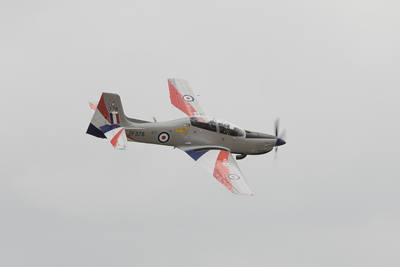
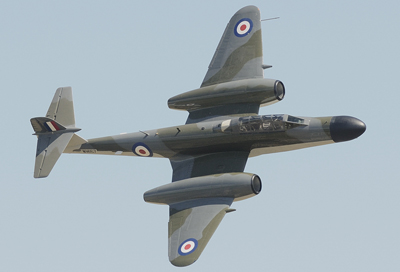
The Gloster Meteor NF11 was the first British jet fighter and the Allies' first operational jet. Designed by George Carter, it first flew in 1943 and commenced operations on 27 July 1944 with 616 Squadron of the Royal Air Force (RAF).
The Gloster Meteor was not an aerodynamically advanced aircraft but the Gloster design team succeeded in producing an effective jet fighter that served the RAF and other air forces for decades.
The Gloster Meteor was not an aerodynamically advanced aircraft but the Gloster design team succeeded in producing an effective jet fighter that served the RAF and other air forces for decades.
Meteors saw action with the Royal Australian Air Force (RAAF) in the Korean War, and remained in service with numerous air forces until the 1970's. Two Meteors, WL419 and WA638, remain in service with the Martin-Baker company as ejection seat testbeds.
The Meteor's construction was all-metal with a tricycle undercarriage and conventional low, straight wings, featuring turbojets mid-mounted in the wings with a high-mounted tailplane to keep it clear of the jet exhaust.
The Meteor's construction was all-metal with a tricycle undercarriage and conventional low, straight wings, featuring turbojets mid-mounted in the wings with a high-mounted tailplane to keep it clear of the jet exhaust.
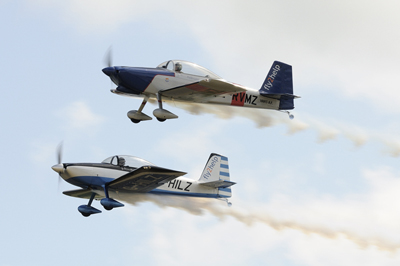
The Van’s RV-8 is a tandem two-seat, single-engine, low-wing homebuilt aircraft sold in kit form by Van’s Aircraft. The RV-8 is equipped with conventional landing gear, while the RV-8A version features tricycle landing gear.
The design is a larger development of the RV-4, and is similar in appearance to the earlier model. Richard VanGrunsven designed the RV-8 series as an improved RV-4, which was a two-seat version of the single seat RV-3. The RV-8 first flew in 1995 and was first shown publicly at Oshkosh that year.
The design is a larger development of the RV-4, and is similar in appearance to the earlier model. Richard VanGrunsven designed the RV-8 series as an improved RV-4, which was a two-seat version of the single seat RV-3. The RV-8 first flew in 1995 and was first shown publicly at Oshkosh that year.
The RV-8 was intended from the start to have a nose-gear stablemate designated the RV-8A. The RV-8A was first flown in 1998 and features tubular steel landing gear with the nosewheel mounting tube welded to the engine mount. As in all nose-wheel equipped RV aircraft, the nosewheel is free castering and the aircraft is steered with differential braking. The brakes are mounted conventionally on the rudder pedal toes.
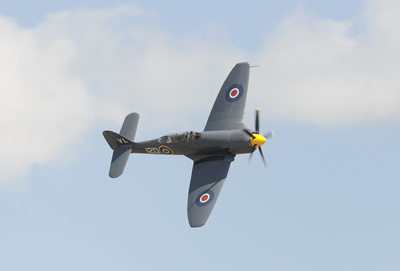
The Hawker Sea Fury VX281 was a British fighter aircraft developed for the Royal Navy by Hawker during the Second World War.
It was the last propeller-driven fighter to serve with the Royal Navy, it was also one of the fastest production single piston-engined aircraft ever built.
The Hawker Fury was an evolutionary successor to the successful Hawker Typhoon and Tempest fighters and fighter-bombers of World War II.
It was the last propeller-driven fighter to serve with the Royal Navy, it was also one of the fastest production single piston-engined aircraft ever built.
The Hawker Fury was an evolutionary successor to the successful Hawker Typhoon and Tempest fighters and fighter-bombers of World War II.
The Fury was designed in 1942 by Sydney Camm, the famous Hawker designer, to meet the Royal Air Force’s requirement for a lightweight Tempest Mk.II replacement. Developed as the "Tempest Light Fighter", it used modified Tempest semi-elliptical outer wing panels, bolted and riveted together on the fuselage centerline. The fuselage itself was similar to the Tempest, but fully monocoque with a higher cockpit for better visibility.
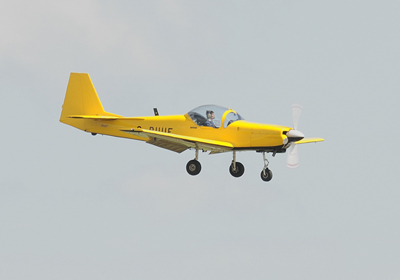
The Firefly flew by Tizi Hodson, she is one of the most experienced women pilots in the UK. She has over 17000 hours in her logbook, 5000 of them accumulated while flying big jets. She spent several years in Africa, bush-flying and then running her own flying school.
At one occasion she flew a Mooney light aircraft solo from South Africa to the UK and then across the Atlantic to Florida.
She is also an accomplished contest aerobatics pilot, twice winning the British Association’s “Leading Lady in Aerobatics” throphy.
At one occasion she flew a Mooney light aircraft solo from South Africa to the UK and then across the Atlantic to Florida.
She is also an accomplished contest aerobatics pilot, twice winning the British Association’s “Leading Lady in Aerobatics” throphy.
The Slingsby T67 Firefly, originally produced as the Fournier RF-6, is a two-seat aerobatic training aircraft, built by Slingsby Aviation in Kirkbymoorside, Yorkshire, England. It has been successfully used by the UK armed forces and other military training schools around the world for many years as a very competent basic trainer, and is operated safely by many private individuals for standard-level aerobatics. However, it developed a bad reputation in the United States after three fatal crashes during USAF training operations.
In 1981, Fournier sold the development rights of the RF-6B to Slingsby who renamed it the T67. The earliest examples, the T67A, were virtually identical to the Fournier-built aircraft, but the design was soon revised to replace the wooden structure with one of composite material. Slingsby produced several versions developing the airframe and adding progressively larger engines. The Slingsby T67M, aimed at the military (hence "M") training market, was the first to include a constant speed propeller and inverted fuel and oil systems.
In 1981, Fournier sold the development rights of the RF-6B to Slingsby who renamed it the T67. The earliest examples, the T67A, were virtually identical to the Fournier-built aircraft, but the design was soon revised to replace the wooden structure with one of composite material. Slingsby produced several versions developing the airframe and adding progressively larger engines. The Slingsby T67M, aimed at the military (hence "M") training market, was the first to include a constant speed propeller and inverted fuel and oil systems.
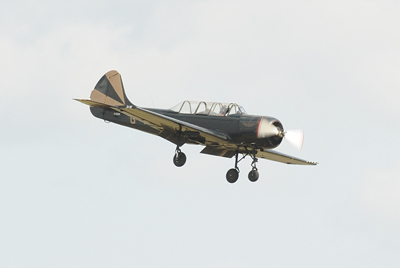
The Yakovlev Yak-52 is a Soviet primary trainer aircraft which first flew in 1976.
It is still being produced in Romania by Aerostar, which gained manufacturing rights under agreement within the now defunct COMECON socialist trade organisation.
The Yak-52 was designed originally as an aerobatic trainer for students in the Soviet DOSAAF training organisation, which trained both civilian sport pilots and military pilots.
It is still being produced in Romania by Aerostar, which gained manufacturing rights under agreement within the now defunct COMECON socialist trade organisation.
The Yak-52 was designed originally as an aerobatic trainer for students in the Soviet DOSAAF training organisation, which trained both civilian sport pilots and military pilots.
Since the early 1990s and the fall of the Soviet Union, many Yak 52s have been exported to the west. Of the approximately 1,800 produced to date, most now fly in the United States, United Kingdom, New Zealand, Australia and other western countries.
The all-metal Yak-52 is powered by a 268 kW (360 hp) Vedeneyev M14P 9-cylinder radial engine. The aircraft has inverted fuel and oil systems permitting inverted flight for as long as two minutes. The engine drives a two-bladed counter-clockwise rotating, variable pitch, wood and fiberglass laminate propeller. At 998 kg (2,200 lb) empty weight, the Yak-52 is responsive and very capable as an aerobatic aircraft. Yet it is also easy to fly and land. It has been used in international aerobatic competition up to the Advanced level. It is stressed to +7 and -5 Gs, rolls (to the right) at 180 degrees/second.
The Yak-52, like most Soviet military aircraft, was designed to operate in rugged environments with minimal maintenance. One of its key features, unusual in western aircraft, is its extensive pneumatic system. Engine starting, landing gear, flaps, and wheel brakes are all pneumatically actuated. Spherical storage bottles for air, replenished by an engine driven compressor, are situated behind the rear cockpit and contents displayed on the instrument panels.
The tricycle landing gear is retractable, but it remains partially-exposed in the retracted position, affording both a useful level of drag in down manoeuvres and a measure of protection should the plane be forced to land "wheels up."
The all-metal Yak-52 is powered by a 268 kW (360 hp) Vedeneyev M14P 9-cylinder radial engine. The aircraft has inverted fuel and oil systems permitting inverted flight for as long as two minutes. The engine drives a two-bladed counter-clockwise rotating, variable pitch, wood and fiberglass laminate propeller. At 998 kg (2,200 lb) empty weight, the Yak-52 is responsive and very capable as an aerobatic aircraft. Yet it is also easy to fly and land. It has been used in international aerobatic competition up to the Advanced level. It is stressed to +7 and -5 Gs, rolls (to the right) at 180 degrees/second.
The Yak-52, like most Soviet military aircraft, was designed to operate in rugged environments with minimal maintenance. One of its key features, unusual in western aircraft, is its extensive pneumatic system. Engine starting, landing gear, flaps, and wheel brakes are all pneumatically actuated. Spherical storage bottles for air, replenished by an engine driven compressor, are situated behind the rear cockpit and contents displayed on the instrument panels.
The tricycle landing gear is retractable, but it remains partially-exposed in the retracted position, affording both a useful level of drag in down manoeuvres and a measure of protection should the plane be forced to land "wheels up."
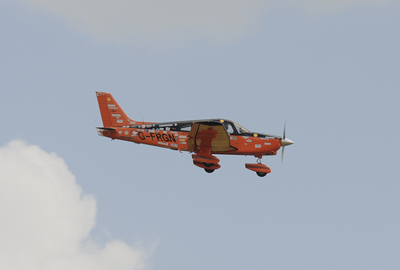
This Piper PA-28-236 Cherokee aircraft has been flown around the world twice by Polly Vacher. Poly is a great proponent of “Flying for the disabled”.
Her other accomplishments are : the first woman to fly solo over the North Pole in a single engine aircraft and the first woman to fly solo in Antarctica in a single engine aircraft.
The Piper PA-28 Cherokee is a family of light aircraft designed for flight training, air taxi, and personal use. It is built by Piper Aircraft.
Her other accomplishments are : the first woman to fly solo over the North Pole in a single engine aircraft and the first woman to fly solo in Antarctica in a single engine aircraft.
The Piper PA-28 Cherokee is a family of light aircraft designed for flight training, air taxi, and personal use. It is built by Piper Aircraft.
All members of the PA-28 family are all-metal, unpressurized, single-engine, piston-powered airplanes with low-mounted wings and tricycle landing gear. They all have a single door on the co-pilot side, which is entered by stepping on the wing. The first PA-28 received its type certificate from the FAA in 1960, and the series remains in production to this day.
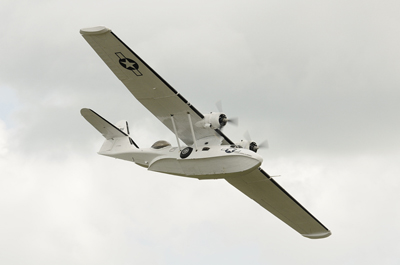
Then it was time for an excellent demonstration of the Consolidate PBY-5A Catalina. This special airplane was built in Canada in 1943 and served the RCAF during the war on antisubmarine patrols, and later on post-war survey duties in the Canadian Arctic and search and rescue tasks in Vancouver.
In 1961, it begun a long career as a water-bomber on firefighting duties, before eventually finding its way to Duxford in 2004.
In 1961, it begun a long career as a water-bomber on firefighting duties, before eventually finding its way to Duxford in 2004.
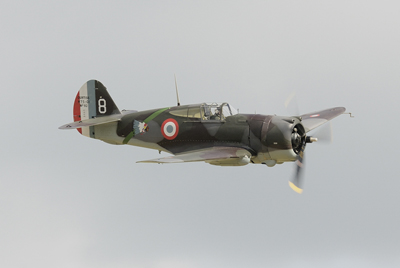
The Curtiss P-36 Hawk, also known as the Curtiss Hawk Model 75, was an American-designed and built fighter aircraft of the 1930's and 40's.
A contemporary of both the Hawker Hurricane and Messerschmitt Bf 109, it was one of the first of a new generation of combat aircraft-a sleek monoplane design making extensive use of metal in its construction and powered by a powerful radial engine.
A contemporary of both the Hawker Hurricane and Messerschmitt Bf 109, it was one of the first of a new generation of combat aircraft-a sleek monoplane design making extensive use of metal in its construction and powered by a powerful radial engine.
Obsolescent at the onset of World War II and best known as the predecessor of the Curtiss P-40 Warhawk, the P-36 saw only limited combat with the United States Army Air Forces, but it was used more extensively by the French Air Force, both during the Battle of France by the Vichy French, and also by the British Commonwealth (where it was known as the Mohawk), and Chinese air units. Several dozens also fought in the Finnish Air Force against the Soviet Air Forces. With around 1,000 aircraft built, the P-36 was a major commercial success for Curtiss.
The Curtiss Model 75 was a private venture by the company, designed by former Northrop Aircraft Company engineer Donovan Berlin. The First prototype constructed in 1934 featured all-metal construction with fabric-covered control surfaces, a Wright XR-1670-5 radial engine developing 900 hp (670 kW), and typical United States Army Air Corps armament of one .30 in (7.62 mm) and one .50 in (12.7 mm) machine guns firing through the propeller arc. Also typical for the time was the total absence of cockpit armor or self-sealing fuel tanks. The distinctive landing gear which rotated 90° to fold the main wheels flat into the thin trailing portion of the wing was actually a Boeing-patented design for which Curtiss had to pay royalties. The prototype first flew on May 6, 1935, reaching 281 mph (452 km/h) at 10,000 ft (3,000 m) during early test flights.
The Curtiss Model 75 was a private venture by the company, designed by former Northrop Aircraft Company engineer Donovan Berlin. The First prototype constructed in 1934 featured all-metal construction with fabric-covered control surfaces, a Wright XR-1670-5 radial engine developing 900 hp (670 kW), and typical United States Army Air Corps armament of one .30 in (7.62 mm) and one .50 in (12.7 mm) machine guns firing through the propeller arc. Also typical for the time was the total absence of cockpit armor or self-sealing fuel tanks. The distinctive landing gear which rotated 90° to fold the main wheels flat into the thin trailing portion of the wing was actually a Boeing-patented design for which Curtiss had to pay royalties. The prototype first flew on May 6, 1935, reaching 281 mph (452 km/h) at 10,000 ft (3,000 m) during early test flights.
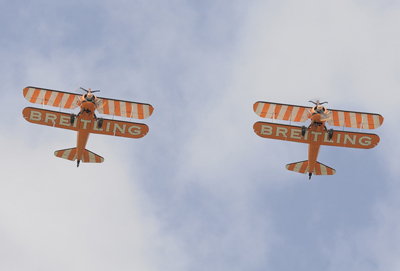
The Breitling Wingwalkers in their ‘Breitling’ colors, they two different types of aerobatics in a truly stunning show : one with planes flying in formation, and another with young women perched on the center of the upper wing and performing a synchronized choreography.
This is a magnificent way of recalling the famous «barnstormers», the teams of pilots and stuntmen who performed in various places in the period between the two world wars.
This is a magnificent way of recalling the famous «barnstormers», the teams of pilots and stuntmen who performed in various places in the period between the two world wars.
This squad is unique in the world and has already made a name it's fame by displaying its blend of daring and precision at countless shows around Europe, as well as on other continents.
The two planes used for the performances are 1940s open-cockpit Boeing Stearman biplanes, characterized by the beautiful signature sound of their 450 HP engines and a smoke trail system that underscores their movements. Breitling has treated them to a brand-new orange livery that makes them stand out even more brightly against the blue expanse of sky.
The two planes used for the performances are 1940s open-cockpit Boeing Stearman biplanes, characterized by the beautiful signature sound of their 450 HP engines and a smoke trail system that underscores their movements. Breitling has treated them to a brand-new orange livery that makes them stand out even more brightly against the blue expanse of sky.
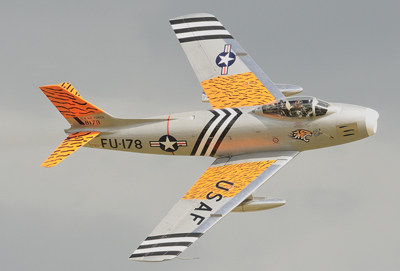
Then the Nord American F-86A Sabre gave a demonstration of its capabilities as a great fighter, today in his “tiger” outfit.
The F-86 Sabre was the West’s first operational swept-wing jet fighter. Fast, with superb handling qualities, the Sabre made its name in the skies over Korea in the early 1950s by shooting down enemy aircraft at a kill/loss ratio of over 10 to 1.Golden Apple’s rare F-86A is the world’s only airworthy ‘A’ model and carries the distinctive colors used by the USAF in Korea.
The F-86 Sabre was the West’s first operational swept-wing jet fighter. Fast, with superb handling qualities, the Sabre made its name in the skies over Korea in the early 1950s by shooting down enemy aircraft at a kill/loss ratio of over 10 to 1.Golden Apple’s rare F-86A is the world’s only airworthy ‘A’ model and carries the distinctive colors used by the USAF in Korea.
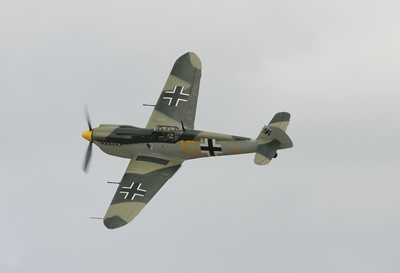
The Hispano Aviacion HA-1112 is a license-built version of the Messerschmitt Bf 109G-2, developed in Spain during and after WWII. It first flew the 29 March 1954, equipped with the 1600 hp Rolls-Royce Merlin 500-45 engine and Rotol propeller.
This engine required the addition of a deep chin intake, whence the name Buchón. Its armament consisted of two 20 mm Hispano-Suiza 404/408 cannons and two Oerlikon or Pilatus eight-packs of 80 mm rockets. It remained in service until 27 December 1965.
This engine required the addition of a deep chin intake, whence the name Buchón. Its armament consisted of two 20 mm Hispano-Suiza 404/408 cannons and two Oerlikon or Pilatus eight-packs of 80 mm rockets. It remained in service until 27 December 1965.
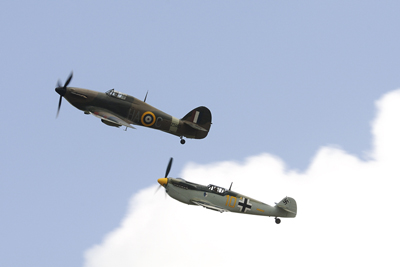
The Supermarine 361 Spitfire LF9B is a British single-seat fighter aircraft used by the Royal Air Force and many other Allied countries throughout the Second World War and on into the 1950s as a front line fighter and also in secondary roles.
It was produced in greater numbers than any other Allied fighter design and was the only Allied fighter in production throughout the war. The Spitfire was designed as a short-range high-performance interceptor aircraft by R. J. Mitchell, chief designer at Supermarine Aviation Works.
It was produced in greater numbers than any other Allied fighter design and was the only Allied fighter in production throughout the war. The Spitfire was designed as a short-range high-performance interceptor aircraft by R. J. Mitchell, chief designer at Supermarine Aviation Works.
The Spitfire's elliptical wing had a thin cross-section, allowing a higher top speed than the Hawker Hurricane and several contemporary fighters. Speed was seen as essential to carry out the mission of home defense against enemy bombers.
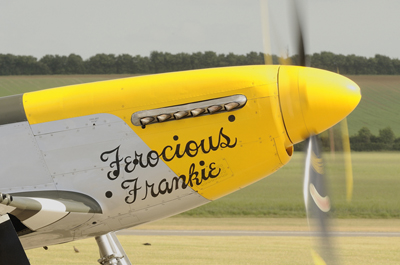
The North American P-51D Mustang, first built in response to an order from the British, the prototype was designed and built in just 117 days and the type was in production before the US government took an interest.
Early Mustangs with Alison engines were under-powered and rather disappointing performers. Mating the airframe with the Packard-built Rolls-Royce Merlin engine turned the Mustang into one of the world’s greatest fighters.
Early Mustangs with Alison engines were under-powered and rather disappointing performers. Mating the airframe with the Packard-built Rolls-Royce Merlin engine turned the Mustang into one of the world’s greatest fighters.
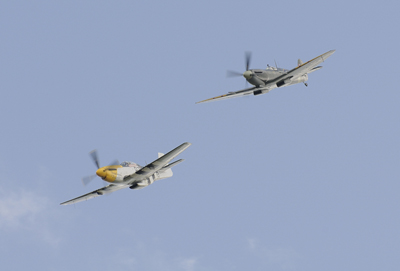
The Hawker Hurricane was the RAF’s first low-wing single seat monoplane fighter with a retractable undercarriage. Designed and predominantly built by Hawker Aircraft Ltd.
It entered service a year before its famous partner the Spitfire, and was credited with shooting down more enemy aircraft than the Spitfire during the Battle of Britain.
It entered service a year before its famous partner the Spitfire, and was credited with shooting down more enemy aircraft than the Spitfire during the Battle of Britain.
The 1930s design evolved through several versions and adaptations, resulting in a series of aircraft which acted as interceptor-fighters, fighter-bombers (also called "Hurribombers"), and ground support aircraft. Further versions known as the Sea Hurricane had modifications which enabled operation from ships. Some were converted as catapult-launched convoy escorts, known as "Hurricats". More than 14,000 Hurricanes were built by the end of 1944 (including about 1,200 converted to Sea Hurricanes.
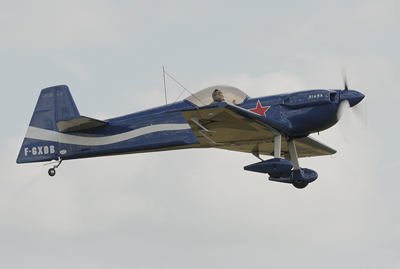
The CAP 232 Flew by Diana Britten, who represented the UK at the World Aerobatic Championship in 1986 and for another ten years at the European and World Championships.
In 1995 she was the British Unlimited Aerobatic Champion and subsequently, she became the British Freestyle Champion. Having retired from competition flying, Diana now flies Displays throughout the UK and Europe.
In 1995 she was the British Unlimited Aerobatic Champion and subsequently, she became the British Freestyle Champion. Having retired from competition flying, Diana now flies Displays throughout the UK and Europe.
The CAP Aviation CAP-23x family is a family of high-performance aircraft designed for competition aerobatics. The CAP 230 airframe was a direct development of the CAP 21 competition single seater strengthened to cope with a 300 hp 6-cylinder Lycoming AEIO-540 engine instead of the 200 hp original 4-cylinder Lycoming AEIO-360.
The CAP 230 was primarily developed in 1985 for the French Air Force. From the basic CAP 21 airframe, trailing edge apex triangular surfaces were added to the basic trapezoidal wing. The CAP 230 keeps a full wooden construction and certified to cope with +10/-10 G-forces.
The CAP 231 was developed in 1990. The fuselage design remained unchanged and only leading edge triangular apex surfaces were added to reduce buffeting during high G pull-ups. The CAP 231 was world champion in 1990.
The CAP 232 alike the -230 and -231/-231EX were slightly modified to strengthen the fuselage structure after a fatal accident in 2005 which grounded them for a full year. Fuselage rib n°2 holding the landing gear and the wing spar has been reinforced externally and internally. The planes are now back in competition and were second (individual with a -231EX), sixth with a -232, and first team at the WAC 2007. After 20 years, the basic CAP 230 airframe is still competitive.
The CAP 230 was primarily developed in 1985 for the French Air Force. From the basic CAP 21 airframe, trailing edge apex triangular surfaces were added to the basic trapezoidal wing. The CAP 230 keeps a full wooden construction and certified to cope with +10/-10 G-forces.
The CAP 231 was developed in 1990. The fuselage design remained unchanged and only leading edge triangular apex surfaces were added to reduce buffeting during high G pull-ups. The CAP 231 was world champion in 1990.
The CAP 232 alike the -230 and -231/-231EX were slightly modified to strengthen the fuselage structure after a fatal accident in 2005 which grounded them for a full year. Fuselage rib n°2 holding the landing gear and the wing spar has been reinforced externally and internally. The planes are now back in competition and were second (individual with a -231EX), sixth with a -232, and first team at the WAC 2007. After 20 years, the basic CAP 230 airframe is still competitive.
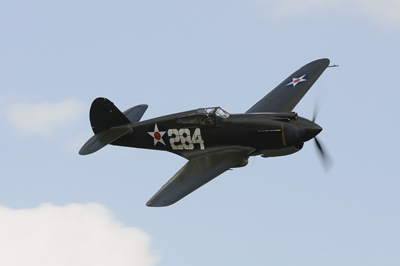
The Curtiss P-40 was an American single-engine, single-seat, all-metal fighter and ground attack aircraft that first flew in 1938. It was used by the air forces of 28 nations, including those of most Allied powers during World War II, and remained in front line service until the end of the war. By November 1944, when production of the P-40 ceased, 13,738 had been built.
The P-40 had good agility, especially at high speed and medium to low altitude. It was one of the tightest-turning monoplane fighters of the war.
The P-40 had good agility, especially at high speed and medium to low altitude. It was one of the tightest-turning monoplane fighters of the war.
The P-40 design was a modification of the previous Curtiss P-36, this reduced development time and enabled a rapid entry into production and operational service. Warhawk was the name the United States Army Air Corps adopted for all models, making it the official name in the United States for all P-40s. The British Commonwealth and Soviet air forces used the name Tomahawk for models equivalent to the P-40B and P-40C, and the name Kittyhawk for models equivalent to the P-40D and all later variants.
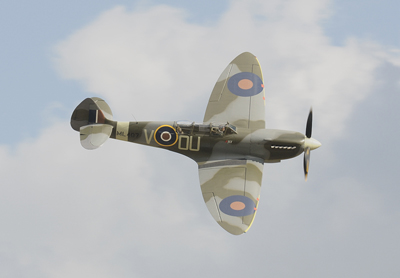
The Spitfire ML407 flew by Carolyn Grace, who has displayed the Spitfire for twenty years, clocking up more than 800 hours and participating in some 600 displays.
Taking up the task of keeping this airplane flying after the untimely death of her husband Nick. Carolyn had the satisfaction in 2009 of seeing her son Richard begin to display the aircraft.
Taking up the task of keeping this airplane flying after the untimely death of her husband Nick. Carolyn had the satisfaction in 2009 of seeing her son Richard begin to display the aircraft.
The “Grace Spitfire” was originally built at Castle Bromwich in early 1944 as a single seat fighter, and served in the front line of battle throughout the last twelve months of WWII, with six different Squadrons of the RAF's 2nd Tactical Air Force, all in all flying 176 operational combat sorties. It was delivered to 485 New Zealand Squadron on the 29th of April 1944 by Jackie Moggridge, one of the top lady pilots of the ATA, where it became the 'mount' of Flying Officer Johnnie Houlton DFC who was accredited, whilst flying ML407, with the first enemy aircraft shot down over the Normandy beach head on D-Day.
In December of 1944, ML407 was transferred to 341 Free French Squadron, becoming the aircraft of Sergeant Jean Dabos. It then moved on through 308 (Polish ) Squadron, 349 (Belgian) Squadron, 345 (Free French) Squadron, 332 (Norwegian) Squadron, and back to 485 (New Zealand) Squadron, before being converted in 1950 to the 2 seat configuration by Supermarine at Southampton as an advanced trainer for the Irish Air Corps where she flew until 1960. She was used for the film 'Battle of Britain' and was then sold to the Strathallan Museum from where she was acquired by engineer Nick Grace in 1979.
Nick spent five years meticulously restoring the Grace Spitfire to flying condition as a 2-seat Spitfire, and completed this incredible project in 1985, when, on the 16th of April, the Grace Spitfire flew again, with Nick's capable hands at the controls. Nick went on to fly it at many air displays and for the movie-business, including 'Perfect Lady' and 'Piece of Cake'. A cruel twist of fate occurred when Nick Grace was tragically killed in a car accident in 1988, and his widow Carolyn Grace took on the task of learning to fly the Spitfire, which you can find documented in the film 'Going Solo'. As can be seen in the film, Carolyn successfully completed her training by 'going solo' in the Spitfire in 1990, and did not look back since, getting her Display Authorisation in 1991, and adding Aerobatic and Formation qualifications since.
The Spitfire is based in Hangar Two at the Imperial War Museum in Duxford, Cambridgeshire, UK, and is maintained by our own Team of engineers at our maintenance facility at Bentwaters in Suffolk. Carolyn flies the Grace Spitfire at many airshows, both public and private, up and down the United Kingdom. She has flown in numerous large celebratory Spitfire Formations including at Duxford the Diamond 16, the 'Big Wing' Formation with 23 Spitfires and more recently this year the Diamond 9 to celebrate 90 years of flying at Duxford.
In December of 1944, ML407 was transferred to 341 Free French Squadron, becoming the aircraft of Sergeant Jean Dabos. It then moved on through 308 (Polish ) Squadron, 349 (Belgian) Squadron, 345 (Free French) Squadron, 332 (Norwegian) Squadron, and back to 485 (New Zealand) Squadron, before being converted in 1950 to the 2 seat configuration by Supermarine at Southampton as an advanced trainer for the Irish Air Corps where she flew until 1960. She was used for the film 'Battle of Britain' and was then sold to the Strathallan Museum from where she was acquired by engineer Nick Grace in 1979.
Nick spent five years meticulously restoring the Grace Spitfire to flying condition as a 2-seat Spitfire, and completed this incredible project in 1985, when, on the 16th of April, the Grace Spitfire flew again, with Nick's capable hands at the controls. Nick went on to fly it at many air displays and for the movie-business, including 'Perfect Lady' and 'Piece of Cake'. A cruel twist of fate occurred when Nick Grace was tragically killed in a car accident in 1988, and his widow Carolyn Grace took on the task of learning to fly the Spitfire, which you can find documented in the film 'Going Solo'. As can be seen in the film, Carolyn successfully completed her training by 'going solo' in the Spitfire in 1990, and did not look back since, getting her Display Authorisation in 1991, and adding Aerobatic and Formation qualifications since.
The Spitfire is based in Hangar Two at the Imperial War Museum in Duxford, Cambridgeshire, UK, and is maintained by our own Team of engineers at our maintenance facility at Bentwaters in Suffolk. Carolyn flies the Grace Spitfire at many airshows, both public and private, up and down the United Kingdom. She has flown in numerous large celebratory Spitfire Formations including at Duxford the Diamond 16, the 'Big Wing' Formation with 23 Spitfires and more recently this year the Diamond 9 to celebrate 90 years of flying at Duxford.
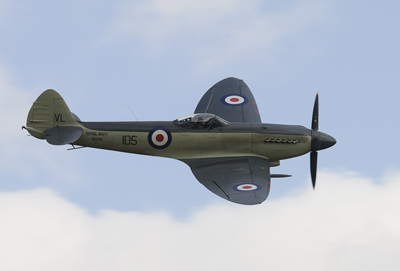
The SeaFire flew by Anna Walker, a fulltime display pilot. The range of Anna’s flying experience is breathtaking : not only does she display her own Bücker Jungmann with sublime skills and demonstrates a banner pick-up in here Piper Club, she also displays a Staggerwing, a Havard, a Chilton racer, a P-51D Mustang and the SeaFire.
In 2009 at Duxford she flew the HAC Hurricane in company with Carolyn Grace in her Spitfire.
In 2009 at Duxford she flew the HAC Hurricane in company with Carolyn Grace in her Spitfire.
The SeaFire, a navalised version of the Supermarine Spitfire, was one of the last piston-engined aircraft to be used by the Royal Navy, before the jet-powered types such as the Sea Hawk arrived. It was especially adapted for operations from aircraft carriers. With a short Griffon nose, four-blade propeller, cut-down rear fuselage, streamlined bubble canopy and normal-size fin, the Mk. XVII looked unlike any other Spitfire/Seafire mark and was also arguably the best looking of all the Seafires. 233 of this variant were produced.
The name Seafire is a contraction of ‘Sea Spitfire’.
The name Seafire is a contraction of ‘Sea Spitfire’.
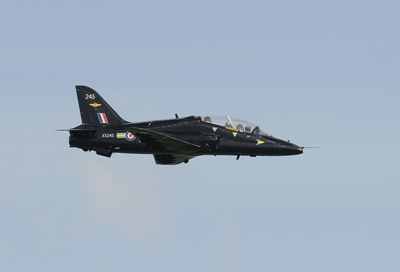
Next, a demonstration of the BAe Hawk piloted by Flt Lt Juliette Fleming of the 208 (R) Squadron. She is the official and the first female Hawk display pilot.
The Hawk is the first jet aircraft that a student pilot will fly in the RAF and is used to teach operational tactics, weapons firing, air combat and low-level operating procedures. Powered by a Rolls-Royce Turbomeca Adour turbofan, the Hawk has a top speed of 550 knots and a ceiling of 48000 feet.
The Hawk is the first jet aircraft that a student pilot will fly in the RAF and is used to teach operational tactics, weapons firing, air combat and low-level operating procedures. Powered by a Rolls-Royce Turbomeca Adour turbofan, the Hawk has a top speed of 550 knots and a ceiling of 48000 feet.
The Hawk has been in RAF services for almost three decades and is the most successful training aircraft in the world. Featuring a digital cockpit, this Hawk, makes it easier for students to undertake the transition to advanced aircraft such as the Typhoon F2.
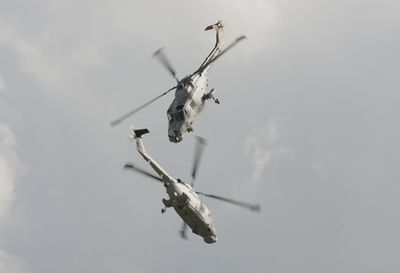
The Black Cats are the official helicopter display team of the RAF since 2001, first under the name “The Lynx Pair”, then from 2004 as “The Black Cats”.
The name “Black Cats” is derived from a combination of the Lynx wildcat on the squadron badge and “black catting”, the naval slang for one-upmanship.
The 2011 team is led by Lt Chris Chambers with Lt Dave Fleming as “Black Two”.
The name “Black Cats” is derived from a combination of the Lynx wildcat on the squadron badge and “black catting”, the naval slang for one-upmanship.
The 2011 team is led by Lt Chris Chambers with Lt Dave Fleming as “Black Two”.
The Westland Lynx is a British multi-purpose military helicopter designed and built by Westland Helicopters at its factory in Yeovil. Originally intended as a utility craft for both civil and naval usage, military interest led to the development of both battlefield and naval variants. The Lynx went into operational usage in 1977 and was later adopted by the armed forces of over a dozen nations, primarily serving in the battlefield utility, anti-armour, search and rescue and anti-submarine warfare roles. In 1986 a specially modified Lynx set the current Fédération Aéronautique Internationale's official airspeed record for helicopters. The helicopter is now produced and marketed by Agusta Westland.
After over 40-years of service the Lynx will retire from the Royal Navy in 2007, to be replaced by a similar looking but significantly more capable AW159 Lynx Wildcat.
After over 40-years of service the Lynx will retire from the Royal Navy in 2007, to be replaced by a similar looking but significantly more capable AW159 Lynx Wildcat.